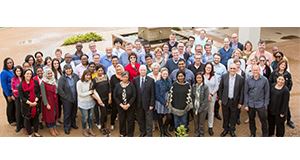8th Annual HIV Prevention Workshop 2017
Hosted by CAPRISA, the Ragon Institute, and the HIV Pathogenesis Programme, the 8th annual HIV Prevention Workshop was held in the lush KwaZulu-Natal Midlands from 14-17 November.
This year, sessions focused on the latest advancements in research pertaining to: HIV pre-exposure prophylaxis (PrEP); the vaginal microbiome; understanding the immunogenetics of HIV disease; harnessing broadly neutralising antibodies as PrEP; eliciting effective anti-HIV vaccine responses; and advancing the HIV cure agenda.
CAPRISA’s Director, Salim Abdool Karim, opened the meeting with a discussion about the state of the global HIV epidemic, explaining that HIV incidence remains unacceptably high, and that young women are disproportionately affected. He emphasised of the need for better combination HIV prevention within the scope of the ongoing HIV pandemic. The session on PrEP included descriptions of exciting new ARV-based PrEP regimens and delivery models (Gustavo Doncel, Walid Heneine), and inspired hope for current and planned clinical trials. Collectively, the presenters highlighted the importance of understanding biological and behavioural factors that can modify PrEP effects, and to focus investigations on ways to modify these to improve efficacy.
The microbiome session highlighted the gaps and challenges in translating the vaginal microbiome (Doug Kwon/Caroline Mitchell), and invited much discussion on the impact of the vaginal microbiome on HIV risk and prevention (Jo-Ann Passmore). The speakers described the complexities of host–microbial interactions in the female genital tract, the importance of understanding what constitutes a “normal” or “healthy” genital mucosa, factors that contribute towards the transition to bacterial vaginosis.
The immunogenetics of HIV disease was described succinctly by Mary Carrington and was complemented by further descriptions of the utility of single cell transcriptomics profiling (Sam Kazer), and the importance of addressing systematically the relationship between HLA expression and immune cell responses in the prevention of HIV, and other diseases (Veron Ramsuran/Emily Wong).
Nicole Doria Rose began the bnAbs session on a “good note” with a comprehensive overview of bnAbs in HIV prevention. The session featured updates on the PGT121/PGDM1400 NHP and human trials (Boris Juelg/Katy Stephensen), the neutralization capacity of transmitted/founder viruses by bNabs (Bongiwe Ndlovu), and exciting work from Dennis Burton showing rapid production of bnAbs in cows on immunization with BG505 SOSIP.
The vaccine session began with a description of the landscape of current and future HIV vaccine trials (Nigel Garrett and Kathy Mngadi). Featured work included that of Tim Schacker who highlighted the role of lymphoid tissue fibrosis on the development of effective vaccine responses, and by Bill Schief, who described the utility of germ line vaccination to induce bNAbs. The session on HIV cure highlighted the importance of locating HIV reservoirs (Melissa-Rose Abrahams, Kavidha Reddy), characterising the features of biomarkers associated with cure (Madeleine Jennewein), and of using post-vaccination immunology as a tool to predict future vaccine efficacy (Dan Barouch).
Besides involvement in top-class science, the meeting delegates were also treated to zipline adventures through the Karkloof canopies in Howick, to tandem soars on a glider, and spectacular views of the uncharacteristically snowy Drakensberg mountain peaks in summer. In keeping with the outcomes of previous meetings, delegates left with great optimism for HIV prevention with several HIV vaccine clinical trials underway, and exiting new products in the pipeline for PrEP, vaccines and cure.
- Lenine Liebenberg (Research Associate, CAPRISA)

Delegates from the Ragon Institute at Harvard, CAPRISA and the HPP at the 8th annual HIV Prevention workshop held at the Fordoun Hotel in the KwaZulu-Natal Midlands, South Africa.
